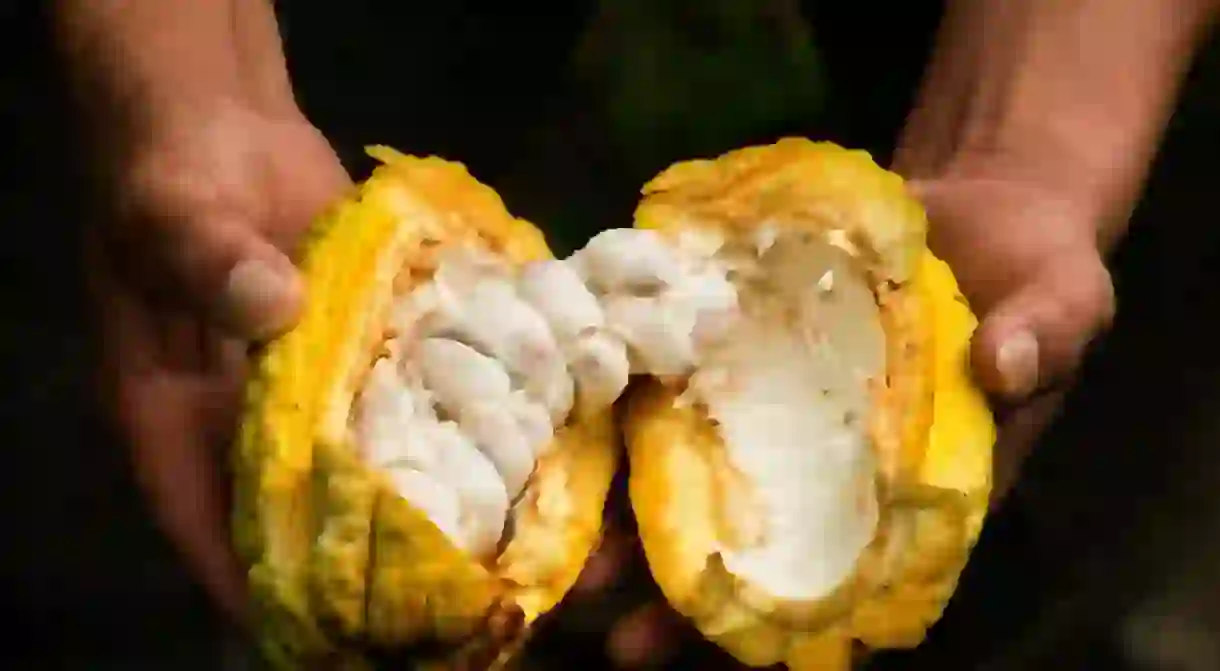Cacao: Mexico's Gift to the World

Cacao, the 4,000-year-old tropical plant, is one of Mexico’s greatest gifts to the world. This plant took over the planet as one of the most delectable flavors to the human palate.
The word cacao comes from the Nahuatl cacahuatl and the Maya kakaw and is thought to mean strong, red fruit – probably owing to the fortifying qualities of cacao when ingested. This is a picky plant, refusing to grow beyond 20 degrees latitude to the north or south of equator, endemic to the tropical and subtropical zones of the Americas. Spanish conquistadors whispered about sacred Maya cacao groves that allowed them to grow cacao beyond those geogrpahically limitations. Today scientists believe these groves were located inside the sinkholes (called cenotes) which offered the trees shade and a constant source of fresh water from underground rivers.

The plant’s first known domestication was by the Mayan people 2,000 years ago. Cacao existed long before that, but the people of Central and South America familiar with it simply sucked its fatty, white outer coating off and discarded the inner seed or “almond” to be eaten by birds and other animals. It was the Maya who began to dry and toast the cacao seeds to use in recipes and as currency. The use of cacao as food during the pre-Hispanic era was deeply ritualistic and reserved for special occasions. It was only available to the upper echelons of Maya and then Mexican society – the seeds were so highly valued it was virtually impossible for the working poor to obtain them.

Spanish historians recorded the use of several different kinds of cacao plants when they arrived in the New World, some were used in food and drink, others as currency, and one particular, as a type of alms for the poor. When the Spanish began to monopolize production of cacao during the colonial period in Mexico, traditional drinks and cooking techniques gradually transformed (cold to hot, bitter to sweetened, a water base to a milk base) creating the form of chocolate known today around the world.

The fruit of the cacao tree grows from the branches and trunk of the trees, they have a hard outer shell and are harvested at their ripest, split open and relieved of their white, sticky inner seeds. The fresh cacao seeds, with their fatty outer layer, are deposited in wooden boxes and fermented in the tropical heat, changing their color, flavor and smell to ones we are familiar with as “chocolatey.” After about seven days in the fermentation tanks the seeds are taken out to dry under the sun, later they are toasted. The dried, toasted cacao seeds are then ground (traditionally in Mexico on a metate – a flat mortar and pestle made from volcanic rock) and added to drinks and sauces, or in the case of commercial cacao production, shipped around the world to make chocolate bars, powders, drinks and additives.

While the modern world has been seduced by the sweet bars of Belgium and the milky-sweet hot chocolate of France, Mexico’s indigenous communities still make many of the traditional cacao drinks and sauces in their communities. Although slight adjustments have been made for the modern-day palate, in Mexico you can still find cold cacao drinks, spicy sauces with cacao, and foamy, cinnamony hot chocolate made with water. Some of cacao’s most familiar Mexican preparations are:
Oaxacan Hot Chocolate
Noted for its cinnamon and spice, Oaxacan hot chocolate is sold throughout Mexico. It is blended with water using a molinillo to make a frothy and delicious hot chocolate.
Mole Poblano
One of Mexico’s most famous culinary exports, mole poblano is a blend of toasted cacao seeds, chiles, nuts, and spices with the possible addition of banana or even old tortillas. All the ingredients are blended into a paste and mixed with either chicken or vegetable stock and served over (most commonly) chicken or turkey.
Tejate
A cold chocolatey drink found in the southern state of Oaxaca, tejate is a blend of cacao, corn, cacao flowers and was once a drink that honored the beginning of the corn harvest for the indigenous peoples of Mexico.
Cacao
With the same name as the fruit, this traditional drink is made from ground cacao seeds, fava beans, corn, cinnamon, and anise and is sweetened with piloncillo.














